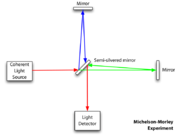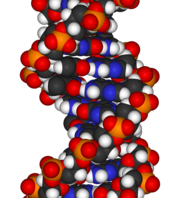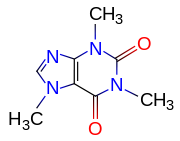[edit] Cosmology and High energy physics
- Accelerating universe and the Cosmological constant
- Why doesn't the zero-point energy of the vacuum cause a large cosmological constant? What cancels it out? Is a non-total cancellation of the cosmological constant responsible for the observed accelerated expansion (deSitter phase) of the Universe? If it is, why is the energy density of the cosmological constant of the same magnitude as the density of matter at present when the two evolve quite differently over time; could it be simply that we are observing at exactly the right time? Or is the nature of the dark energy driving this acceleration different?
- Baryon asymmetry
- Why is there far more matter than antimatter in the universe?
- Dark matter
- What is dark matter?[1] Is it related to supersymmetry? Do the phenomena attributed to dark matter point not to some form of matter but actually to an extension of gravity?
- Electroweak symmetry breaking
- What is the mechanism responsible for breaking the electroweak gauge symmetry, giving mass to the W and Z bosons? Is it the simple Higgs mechanism of the Standard Model?[2] or does nature make use of strong dynamics in breaking electroweak symmetry, as proposed by Technicolor?
- Entropy (arrow of time)
- Why did the universe have such low entropy in the past, resulting in the distinction between past and future and the second law of thermodynamics?[3]
- Neutrino mass
- What is the mechanism responsible for generating neutrino masses? Is the neutrino its own antiparticle?
- Proton Spin Crisis
- As initially measured by the European Muon Collaboration, the 3 main ("valence") quarks of the proton account for about 12% of its total spin. Can the gluons that bind the quarks together, as well as the "sea" quark pairs that are continually being created and annihilating, properly account for the rest of it?**
- Quantum chromodynamics (QCD) in the non-perturbative regime
- The equations of QCD remain unsolved at energy scales relevant for describing atomic nuclei, and only mainly numerical approaches seem to begin to give answers at this limit. How does QCD give rise to the physics of nuclei and nuclear constituents?
- Strong CP problem and Axions
- Why is the strong nuclear interaction invariant to parity and charge conjugation? Is the Peccei-Quinn theory (i.e. mechanism) the solution to this problem? What are the properties of the predicted axion?
[edit] Astronomy
- Accretion disc jets
- Why do the accretion discs surrounding certain astronomical objects, such as the nuclei of active galaxies, emit relativistic jets along their polar axes?
- Corona heating problem
- Why is the Sun's Corona (atmosphere layer) so much hotter than the Sun's surface?
- Gamma ray bursts (short duration)
- What is the nature of these extraordinarily energetic astronomical objects that last less than two seconds?[4]
- Hipparcos Anomaly
- How far away are the Pleiades, exactly?**
- Pioneer anomaly
- What causes the apparent residual sunward acceleration of the Pioneer spacecraft?[5][6] ****
- Ultra-high-energy cosmic ray
- Why is it that some cosmic rays appear to possess energies that are impossibly high (the so called Oh-My-God particle), given that there are no sufficiently energetic cosmic ray sources near the Earth? Why is it that (apparently) some cosmic rays emitted by distant sources have energies above the Greisen-Zatsepin-Kuzmin limit?[7][8]
[edit] Condensed matter physics
- Amorphous solids
- What is the nature of the transition between a fluid or regular solid and a glassy phase? What are the physical processes giving rise to the general properties of glasses?
- High-temperature superconductors
- What is the responsible mechanism that causes certain materials to exhibit superconductivity at temperatures much higher than around 50 kelvins?[9]
- Sonoluminescence
- What causes the emission of short bursts of light from imploding bubbles in a liquid when excited by sound?
- Turbulence
- Is it possible to make a theoretical model to describe the statistics of a turbulent flow (in particular, its internal structures)?[10]
[edit] Theoretical problems
The following problems are either fundamental theoretical problems, or theoretical ideas which lack experimental evidence and are in search of one, or both, as most of them are.
Some of the following problems are strongly interrelated. For example, extra dimensions or supersymmetry may solve the Hierarchy problem. It is thought that most of these problems (not including the Island of stability problem) should be answered by a full theory of quantum gravity.
[edit] Quantum gravity and cosmology
- Quantum gravity
- How can gravity and general relativity be realized as a fully consistent quantum field theory? Is string theory (M-theory) the correct approach? More pressing, how much experimental information can be extracted about physics near Planck scale?
- Black holes, Black hole information, Black hole radiation and structure
- Do black holes really exist? Do they radiate, as expected on theoretical grounds? Does this radiation contain information about their inner structure, as suggested by Gauge-gravity duality, or not, as implied by Hawking's original calculation? If not, and black holes can evaporate away, what happens to the information stored in it? (Quantum mechanics does not allow information to be destroyed) Or does the radiation stop at some point leaving black hole remnants? Is there another way to probe their internal structure somehow, if such a structure even exists?
- Extra dimensions
- Does nature have more than four spacetime dimensions? If so, what is their size? Are dimensions a fundamental property of the universe or an emergent result of other physical laws?
- Cosmic inflation
- Is the theory of cosmic inflation correct, and if so, what are the details of this epoch? What is the hypothetical inflaton field giving rise to inflation? Is there a natural explanation for its peculiar proposed potential? If inflation happened at one point, is it self-sustaining through inflation of quantum-mechanical fluctuations, and thus ongoing in some impossibly distant place?
- Multiple universes
- Are there physical reasons to believe in other universes that are fundamentally non-observable? For instance: Are there quantum mechanical "alternate histories"? Are there "other" universes with physical laws resulting from alternate ways of breaking the apparent symmetries of physical forces at high energies, possibly incredibly far away due to cosmic inflation? Is the use of the anthropic principle to resolve global cosmological dilemmas justified? ***
[edit] High energy physics
- Hierarchy problem
- Why is gravity such a weak force? It becomes strong for particles only at the Planck scale, around 1019 GeV, much above the electroweak scale (100 GeV, the energy scale dominating physics at low energies). Why are these scales so different from each other? What prevents quantities at the electroweak scale, such as the Higgs boson mass, from getting quantum corrections of order of the Planck scale? Is the solution supersymmetry, extra dimensions or just anthropic fine-tuning?
- Island of stability
- What is the largest theoretically possible stable atom?
- Magnetic monopoles
- Do particles that carry "magnetic charge" exist?
- Proton decay and Unification
- How do we unify the three different quantum mechanical fundamental interactions of quantum field theory? As the lightest baryon, are protons absolutely stable? If current theoretical ideas are correct, quarks and leptons are ultimately unified and thus nothing in principle forbids proton decay. If so, then what is the proton's half-life?
- Supersymmetry
- Is spacetime supersymmetry realized in nature? If so, what is the mechanism of supersymmetry breaking? Does supersymmetry stabilize the electroweak scale, preventing high quantum corrections? Does the lightest supersymmetric particle make up the dark matter?
[edit] Other problems
- Emergent phenomena
- Is a complete understanding of particle physics sufficient to fully understand all physical phenomena, or are there emergent phenomena in physics whose existence cannot be definitively predicted from a complete understanding of the fundamental particles and forces that govern the universe? ***
- Quantum mechanics in the correspondence limit
- Is there a preferred interpretation of quantum mechanics? How does the quantum description of reality, which includes elements such as the superposition of states and wavefunction collapse, give rise to the reality we perceive? ***
- Physical information
- Are there physical phenomena, such as black holes or wave function collapse, which irrevocably destroy information about their prior states? **
- Theory of everything
- Is there a theory which explains the values of all fundamental physical constants? [11] Do "fundamental physical constants" vary over time? Is there a theory which explains why the gauge groups of the standard model are as they are, why observed space-time has 3+1 dimensions, and why all laws of physics are as they are? Are string theory and the anthropic principle correct directions? Are there any testable consequences of that? ***
[edit] Problems solved recently
- Long duration gamma ray bursts (2003)
- Long-duration bursts are associated with the deaths of massive stars in a specific kind of supernova-like event commonly referred to as a collapsar.
- Solar neutrino problem (2002)
- Solved by a new understanding of neutrino physics, requiring a modification of the Standard Model of particle physics — specifically, neutrino oscillation.
- Age Crisis (1990s)
- The estimated age of the universe was around 3 to 8 billion years younger than estimates of the ages of the oldest stars in our galaxy. Better estimates for the distances to the stars and the addition of dark energy into the cosmological model reconciled the age estimates.
- Quasars (1980s)
- The nature of quasars was not understood for decades. They are now accepted as a type of active galaxy where the enormous energy output results from matter falling into a massive black hole in the center of the galaxy.




